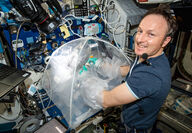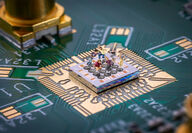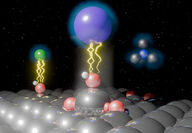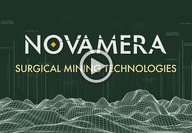Sorted by date Results 1 - 25 of 65

From enhancing virtual reality to controlling tiny scientific samples, dynamic rippling movement manipulates objects magnetically. In science fiction, magnetism has been used to manipulate all manner of materials without touching them, from flying vehicle suspension to containing spheres of antimatter. Meanwhile, a seemingly unrelated long-standing design challenge is communication through touch, a key missing technology in accessibility. There has been a growing demand for...

Launched with Imperial College London as part of an energy transition acceleration program. The global transition to renewable energy will require significant growth in the production and supply of metals and minerals vital to its generation, use, and storage of electricity. The AI boom, increased urbanization, electrification of transportation, and reshoring of mineral production are all playing a role in the growth of a fast-paced and transformative materials industry. As...

Silicon-carbide exterior tiles for reusable commercial spacecraft withstand the fiery temperatures of traversing Earth's atmosphere. Leading commercial space and defense company Sierra Space announced the results of a collaboration with the U.S. Department of Energy's Oak Ridge National Laboratory (ORNL) to create new silicon-carbide-based exterior tiles – called a thermal protection system – for reusable commercial spacecraft. Atmospheric re-entry exposes a craft to bla...

Texas researchers know how to handle heat, boosting cooling by 72%. Few topics among PC enthusiasts spark as much heated debate – literally and figuratively – as the humble thermal paste. Ask any tech head about the ideal amount or application pattern, and you'll likely get a different answer every time. Now, material scientists may have flipped the script with an industry-changing thermal compound boasting unprecedented cooling potential – sorry gamers, it's designed for d...

Breakthrough combination of tech metals manipulates sound to miniaturize and boost devices. Once a passive carrier of vibrations, sound is now being reimagined as a driving force behind a breakthrough in phononic technology, with researchers crafting a revolutionary material that could shrink smartphones to the size of a credit card while boosting performance and energy efficiency. In recent years, phononics – the science of manipulating sound waves – has emerged as a new fron...

Researchers merge light and sound on microchips, unlocking a new frontier in data processing, sensing, and communication. Microchips have always relied on electricity to process data, but what if they could harness sound instead? In a groundbreaking twist, researchers have managed to confine high-frequency sound waves to a chip's surface that ripple like a miniature earthquake – an unexpected breakthrough that could redefine everything from data processing to advanced sensing,...

Researchers from Texas A&M and Sandia National Labs develop 3D-printed joints that adapt to stress, temperature, and movement for stronger structures. In a move that could reshape industries from aerospace to biomedical engineering, researchers from Texas A&M University and Sandia National Laboratories have developed 3D-printed nickel-titanium alloys with shape memory capabilities, paving the way for stronger, more adaptable structures without the need for traditional nuts...

Berkeley Lab team use cutting-edge tech to explore copper efficiency. For over three decades, scientists have chased the dream of room-temperature superconductivity. Now, harnessing the raw power of cutting-edge supercomputers, researchers are unraveling the mysterious interactions within superconductors – unlocking insights that could lead to practical materials capable of conducting electricity with zero resistance, and effectively changing the world as we know it. N...

German scientists demonstrate that precious gems can encapsulate entangled qubits, the quantum version of bits in classic computers. Considering that quantum computers have the potential to solve complex problems in a matter of seconds that would take today's most advanced supercomputers decades to answer, scientists around the world are racing to overcome the challenges associated with developing a quantum computer that is efficient, reliable, and compatible with existing...

Researchers prepare gravity simulations to test lunar soil separation. As part of a NASA-backed project to one day live on the Moon, Missouri University of Science and Technology researchers are gearing up to test a technology that aims to separate lunar soil for building materials under simulated lunar gravity. The team will use special Zero-G flights to see if their prototype can work in Moon-like conditions, bringing us one step closer to sustainable construction on the...

Creates world's first glowing jewels, merging art with groundbreaking science and rare earths. What if a crystal could capture light by day and glow through the night? Thanks to the efforts of a jeweler-turned-scientist, they may have just uncovered that secret, crafting a gemstone like nothing the world has ever seen. What started as a jeweler's curiosity about lab-grown crystals has now transformed into a full-blown scientific breakthrough. After years of experimentation,...

ISS researchers mix together simulated lunar soil, cement, and water to determine microgravity effects. As NASA eyes the Moon for future habitation, an astronaut aboard the International Space Station is already busy mixing the cement, unraveling the mysteries of its hardening process in microgravity. This critical step could determine how we build resilient structures on the Moon and Mars, inching us closer to a permanent human outpost beyond Earth. Building a permanent...

Decades-old theory proved possible as QuTech's "somersaulting" spin qubits simplify control, paving way for scalable quantum computing. Researchers at QuTech have taken a giant leap in quantum computing with the development of "somersaulting" spin qubits, an innovation that simplifies and enhances control of this advanced technology and marks a breakthrough that could revolutionize the construction of powerful quantum processors. Quantum computing, unlike classical computing,...

Pulsar's timely discovery of a massive helium deposit in Minnesota may keep our medical scanners, rockets, and nuclear reactors going. Despite being the second most abundant gas in the universe, there is a definite helium shortage in America, risking the operation of everything from medical diagnostics to cooling nuclear reactors. But the U.S. might finally be in luck – a recently discovered reservoir in Minnesota boasts concentrations pushing 13.8%, the highest the i...

Japanese researchers unveil platinum electrode enhancement for producing clean hydrogen. Imagine a world where clean energy is not just a dream but a reality. Researchers at Chiba University have taken one step closer by cracking the code on platinum electrodes that are vital to hydrogen fuel cells and electrolysis. With subtle changes to the way these electrodes interact with water, they've discovered a game-changing method to boost both efficiency and durability – a small t...

Canada's Global Innovation Cluster for digital technologies invests C$3.5 million in surgical mining of high-grade deposits. Mining tech start-up Novamera has received a $2.6 million (C$3.5 million) investment from Canadian technologies accelerator DIGITAL to advance a technology to surgically mine metals from high-grade deposits that have been overlooked because they are uneconomic with conventional mining technologies due to their size and shape. Many high-grade narrow vein...

A novel light-based method enhances PbS quantum dot solar cells, promising cheaper and more efficient renewable energy. South Korean scientists have discovered a new method to enhance the efficiency of lead-sulfide (PbS) quantum dot solar cells. By using rapid bursts of specialized light instead of prolonged heating, they have found a way to produce cheaper and more effective solar power. At present, the fabrication of PbS solar cells requires a lengthy heat treatment process....

Uses quantum mechanics to discover how light makes thin gold films glow. In a groundbreaking study, researchers at the Swiss Federal Institute of Technology in Lausanne (EPFL) have revealed the quantum secrets behind how light makes thin gold films glow. This discovery, solving a decades-old puzzle, could transform how we make solar fuels and batteries. Luminescence, the process where substances emit photons when exposed to light, has long been observed in semiconductor...

Trucks send seismic waves beneath cities to explore the terrain for oil, gas, faults and geothermal. In 2017, two fleets of massive trucks crossed from Long Beach into Orange County in southern California, sending literal shock waves through the streets. And now, in Germany, they're going to be at it again. The vehicle used to create these vibrations is a seismic vibrator truck or thumper. These trucks use a large weight to thump the ground's surface while sophisticated...

Rio Tinto invests in tech startups, partners with Founders Factory to help establish Western Australia as Silicon Valley of mining tech. Global mining company Rio Tinto has teamed up with world-leading venture studio and start-up investor Founders Factory to help establish the city of Perth on Australia's west coast as the Silicon Valley of mining technologies. As the capital of Western Australia, one of the most productive and diversified mining regions in the world, Perth...

New material bridges anti-gravity tech and super-sensitive instruments. Flying cars and personal jetpacks notwithstanding, a new carbon-based material is bringing us closer to stable levitation technologies with no need for mechanical or electrical assists. Today's levitation uses electrically manipulated magnetic fields, superconductors or diamagnetic (magnetically repelled) materials to float above magnets. The primary use for this is in developing super-sensitive...

Space Agency finds costs and timeframe of previous plan too high, seeks public and private sector innovation to get samples to Earth. In response to Perseverance's successful sample collection efforts, a discussion on returning these samples of Martian geology and potential signs of life back to Earth has been revisited. During a teleconference held early this morning, the National Aeronautics and Space Administration outlined its recommendations regarding a path forward for t...

Begins study to develop first railroad network on the Moon for future extraterrestrial habitation. Invoking a time when Americans began voyaging across the continent in steam-powered engines, Northrop Grumman Corp. has been selected by the Defense Advanced Research Projects Agency to further develop the concept of building a Moon-based railroad network. As part of a broader 10-year Lunar Architecture (LunA-10) Capability Study, this envisioned lunar railroad network would be...

Ames Lab scientists confirm the first ever unconventional superconductor found in nature. Scientists at the Ames National Laboratory in Iowa have made a world's first discovery – a naturally occurring mineral with superconducting properties similar to the high-temperature superconductors that could revolutionize energy, transportation, and electronics. Superconductive materials can conduct electricity without energy loss. Scientists have already created superconductors in the...

Startup sets new standard for orbital industry with scalable, modular thrusters that come with a suite of support tech for seamless operation. Supporting the dreams of countless space-venturing hopefuls, like its namesake, Morpheus Space Inc. has unveiled a potentially game-changing liquid metal ion propulsion system that they believe will chart a path to the stars for smaller companies and organizations to explore the infinite possibilities of endless space. As orbital capabi...